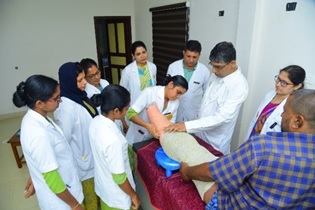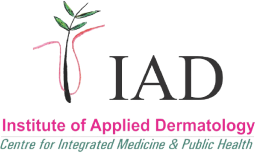Institutes Overview
 In IAD a multi system doctors’ team examines the patient together and inferences of these doctors leads to absorbing the therapeutics of Ayurveda, homoeopathy and Yoga into main stream of patient treatment, albeit using patient care program of Integrative Medicine. IAD has already published on the clinical methods, outcome measures and results on four important diseases affecting Indian population; Lymphatic Filariasis presenting as lymphoedema, Lichen Planus, Vitiligo and Psoriasis.
In IAD a multi system doctors’ team examines the patient together and inferences of these doctors leads to absorbing the therapeutics of Ayurveda, homoeopathy and Yoga into main stream of patient treatment, albeit using patient care program of Integrative Medicine. IAD has already published on the clinical methods, outcome measures and results on four important diseases affecting Indian population; Lymphatic Filariasis presenting as lymphoedema, Lichen Planus, Vitiligo and Psoriasis.
Institute of Applied Dermatology (IAD) in Kasaragod has highlighted the benefits of Integrative Medicine the public health program particularly to manage large number of common diseases affecting the rural populations such as Lymphatic Filariasis. The benefits for other diseases such as Hemiplegia, Vitiligo and Lichen planus have since been published. The doctors compartmentalized systems of medicine because Indian doctors adopted the Western biomedical knowledge without probably imbuing the philosophy behind its development. Patients need relief no matter which system of medicine they take. Historically in the mid 1990s ten allopathic doctors, whose expertise ranged from being family general practitioners, consultant private practitioners, pharmacologists and medical college professors, and known to each other through various platforms; led by local practicing dermatologist, Dr. SR Narahari, shared the common thought that treatment of chronic illness is not adequate in any one given system of medicine. They were keen to explore any other new methods that would benefit patients with chronic problems. Late Prof. Sharadini A Dahanukar, Department of Pharmacology, dean, KEM hospital Mumbai at that time had already worked on ayurvedic system of medicine. Prof. Dahanukar encouraged them to form an NGO in Kasaragod, Kerala and was a co-founder of IAD. Beginning in 1999, the IAD, in Kerala’s northernmost town of Kasaragod, started developing new treatments for skin care, integrating traditional Ayurvedic practices with biomedicine. Some years later in 2004, the Global Programme for the Elimination of Lymphatic Filariasis recommended exploring local health traditions of skin care in the management of Lymphatic Filariasis. Especially, Prof Terence Ryan, Department of Dermatology, Oxford Medical School, outlined his thoughts on developing a low cost treatment paradigm using traditional Indian medicines and yoga, suitable for rural communities. At that time, IAD had already been engaged in such discussions for a number of years, and was looking for collaborators. This led to an exchange and incorporation of Prof Ryan’s recommendations into our work. Subsequently, he closely mentored the whole program.
